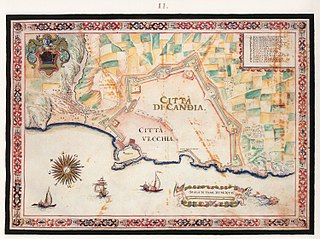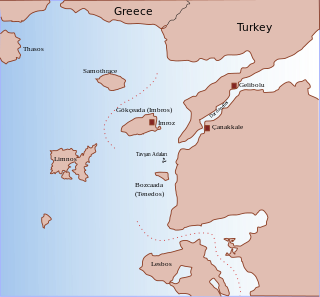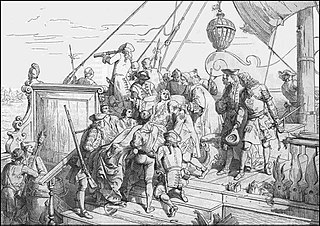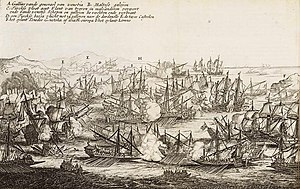
The Battle of Lepanto was a naval engagement that took place on 7 October 1571 when a fleet of the Holy League, a coalition of Catholic states arranged by Pope Pius V, inflicted a major defeat on the fleet of the Ottoman Empire in the Gulf of Patras. The Ottoman forces were sailing westward from their naval station in Lepanto when they met the fleet of the Holy League which was sailing east from Messina, Sicily.

The Holy League of 1571 was arranged by Pope Pius V and included the major Catholic powers of southern Europe, specifically the Spanish Empire as well as the Italian maritime powers. It was intended to break the Ottoman Empire’s control of the eastern Mediterranean Sea and was formally concluded on 25 May 1571. Its members were:

The Battle of Focchies was a significant naval engagement that took place on 12 May 1649, in the harbour of Focchies, Smyrna between a Venetian force of nineteen warships under the command of Giacomo da Riva, and an Ottoman force of eleven warships, ten galleasses, and seventy-two galleys, with the battle resulting in a crushing victory for the Venetian fleet. The battle was an episode in the Cretan War from 1645 to 1669 between the Venetian Republic and the Ottoman Empire over dominance of various territories in the Mediterranean Sea. The war was one in a series of wars between the two warring powers, which contested for control of the Adriatic and Mediterranean trade routes. The primary territory that was contested during the war was Crete, the largest and most profitable of the overseas holdings of the Venetian Republic. The battle came after a squadron of Venetian ships under the command of Giacomo da Riva, a Venetian admiral, came to the rescue of the blockading Venetian force in the Dardanelles Straits, after the blockade had run into unexpected weather conditions and many ships sunk as a result.
This battle took place on 21 June 1655 inside the mouth of the Dardanelles Strait. It was a clear victory for Venice over the Ottoman Empire during the Cretan War.
The Fourth Battle of the Dardanelles in the Fifth Ottoman-Venetian War took place between 17 and 19 July 1657 outside the mouth of the Dardanelles Strait. The Ottomans succeeded in breaking the Venetian blockade over the Straits.
The Battle of Andros took place on 22 August 1696 southeast of the Greek island of Andros between the fleets of the Republic of Venice and the Papal States under Bartolomeo Contarini on the one side and the Ottoman Navy, under Mezzo Morto Hüseyin Pasha, and allied Barbary forces on the other. The encounter was indecisive, and no vessels were lost on either side.
This battle, which took place on 16 May 1654, was the first of a series of tough battles just inside the mouth of the Dardanelles Strait, as Venice and sometimes the other Christian forces attempted to hold the Turks back from their invasion of Crete by attacking them early.

This indecisive naval battle took place on 8 July 1716 during a Turkish attempt to capture the island of Corfu (Kerkyra), off the west coast of mainland Greece.
This battle was fought on 10 July 1651, with some minor fighting on 8 July, south of Naxos in the Greek Islands, between Venetian and Turkish sailing ship/galley forces. It was a Venetian victory.

The Battle of Imbros was a naval clash that took place on 12, 13 and 16 June 1717 near Imbros in the Aegean Sea, between the sailing fleets of Venice and the Ottoman Empire. The outnumbered Venetian Armada Grossa, under the Capitano Straordinario delle Navi Lodovico Flangini, proved herself able to match a superior Turkish force under the Kapudan Pasha Hodja Ibrahim Pasha in a manoeuvred fight that lasted nearly ten days. The outcome of this tough battle was unclear, since both fleet retired to their bases badly damaged, after Flangini died of wounds on the 22nd.
The military history of the Republic of Venice started shortly after its founding, spanning a period from the 9th century until the Republic's fall in the 18th century.

The Morean War, also known as the Sixth Ottoman–Venetian War, was fought between 1684–1699 as part of the wider conflict known as the "Great Turkish War", between the Republic of Venice and the Ottoman Empire. Military operations ranged from Dalmatia to the Aegean Sea, but the war's major campaign was the Venetian conquest of the Morea (Peloponnese) peninsula in southern Greece. On the Venetian side, the war was fought to avenge the loss of Crete in the Cretan War (1645–1669). It happened while the Ottomans were entangled in their northern struggle against the Habsburgs – beginning with the failed Ottoman attempt to conquer Vienna and ending with the Habsburgs gaining Buda and the whole of Hungary, leaving the Ottoman Empire unable to concentrate its forces against the Venetians. As such, the Morean War was the only Ottoman–Venetian conflict from which Venice emerged victorious, gaining significant territory. Venice's expansionist revival would be short-lived, as its gains would be reversed by the Ottomans in 1718.

The Cretan War, also known as the War of Candia or the Fifth Ottoman–Venetian War, was a conflict between the Republic of Venice and her allies against the Ottoman Empire and the Barbary States, because it was largely fought over the island of Crete, Venice's largest and richest overseas possession. The war lasted from 1645 to 1669 and was fought in Crete, especially in the city of Candia, and in numerous naval engagements and raids around the Aegean Sea, with Dalmatia providing a secondary theater of operations.

Lorenzo Marcello was an Italian admiral from the Republic of Venice.

The Fourth Ottoman–Venetian War, also known as the War of Cyprus was fought between 1570 and 1573. It was waged between the Ottoman Empire and the Republic of Venice, the latter joined by the Holy League, a coalition of Christian states formed under the auspices of the Pope, which included Spain, the Republic of Genoa, the Duchy of Savoy, the Knights Hospitaller, the Grand Duchy of Tuscany, and other Italian states.

The siege of Corfu took place on 8 July – 21 August 1716, when the Ottoman Empire besieged the city of Corfu, on the namesake island, then held by the Republic of Venice. The siege was part of the Seventh Ottoman–Venetian War, and, coming in the aftermath of the lightning conquest of the Morea by the Ottoman forces in the previous year, was a major success for Venice, representing its last major military success and allowing it to preserve its rule over the Ionian Islands.

The Battle of Gallipoli occurred on 29 May 1416 between a fleet of the Republic of Venice and the fleet of the Ottoman Empire off the Ottoman naval base of Gallipoli. The battle was the main episode of a brief conflict between the two powers, resulting from Ottoman attacks against possessions and shipping of the Venetians and their allies in the Aegean Sea in 1414–1415. The Venetian fleet, under Pietro Loredan, was charged with transporting Venetian envoys to the Ottoman sultan, but was authorized to attack if the Ottomans refused to negotiate. The subsequent events are known chiefly from a detailed letter written by Loredan after the battle.

Lodovico Flangini was a Venetian noble who served as Capitano Straordinario delle Navi during the Seventh Ottoman–Venetian War.

Lazzaro Mocenigo was a Venetian nobleman who distinguished himself as an admiral during the Cretan War against the Ottoman Empire.













